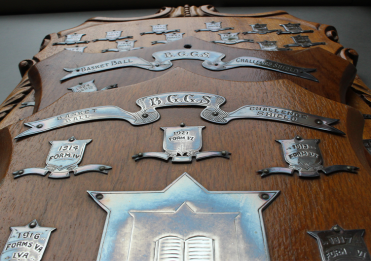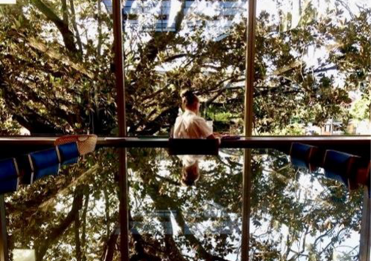Girls Grammar loves its trees. They figure large on the Gregory Terrace campus: be they the towering palms and gnarled frangipani that front Gregory Terrace or the huge Moreton Bay fig at the front of the Elizabeth Jameson Research Learning Centre that was so significant it necessitated numerous arborist visits, enough space for its roots, and the positioning of the RLC far enough back to accommodate its growth. And then there are the other heritage trees on the site and the plantings at Rangakarra that include the grove of learning trees. However, perhaps one of the most ambitious tree projects—but one that is a little more ‘out of sight, out of mind’—is the commemorative grove at the outdoor education centre, Marrapatta. It was an ambitious project and a commemorative booklet meticulously details the name and location of the trees and those who planted them.

The cover of the tree grove commemorative publication.
The Fathers Group always have wonderfully big ideas for what they can contribute to their daughters’ involvement at Girls Grammar, and they always aim to enhance every possible experience for the girls. The year 2000 was the 125th anniversary of the School and the group, under the leadership of landscape architect Trevor Lynch, father of Brooke (1994) and Phoebe (2000), came up with a scheme that combined their desire to value-add to the place they knew as Imbil. It was a place to which they had very close ties and which caused much blood, sweat, tears, innumerable blisters—and an enduring legacy for the outdoor education experience of decades of Grammar girls.

2000 the Principal, Judith Hancock, with Trevor Lynch.
To the west of the main centre was a long, sloping field, one that had obviously been cleared in the centre’s previous incarnation as a dairy farm. To rejuvenate the area and to make the slope reminiscent of the environment it had been, the fathers came up with the idea to plant out the area with a considered collection of more than 600 Australian trees that would add both beauty and an educational perspective. While the celebratory publication called this a tree grove, the signage details a much more ambitious project.

2000 The fathers erecting their commemorative signage.

2000—the bare ground waiting to be rejuvenated.
On 21 May 2000, an enthusiastic crowd of members of the Girls Grammar community descended on Marrapatta to celebrate how far the centre had come, recognise the contributions of Grammar fathers, and plant trees.

2000 The conga line of participants waiting to enter the field pre planting.
Tree planting ceremonies and groves were not a new concept. The School, in its history, has had two groves on the Gregory Terrace campus: the Anzac Grove and a wattle grove. The Anzac Grove was started in 1920 to commemorate the memory of those Anzac soldiers killed in World War I. Three past students, all Red Cross nurses of that war, Sisters Grace Wilson (1899), Gertrude Andrews (1900), and Eunice Paten (1902), each planted a tree. The original grove has since disappeared but, in 2015, a new version was established at Rangakarra with wattles and a lone pine seedling taking pride of place.

Eunice (Ness) Paten.

The Principal, Judith Hancock, planting her red cedar as a father records the location.
In the 1920s and 1930s, there existed a Wattle Day Committee. Alma Hartshorn (1931) remembers a group of wattle trees down the hillside from the Western Wing. A day in June was used by the Wattle Day Committee to raise funds for charitable purposes, and on those occasions, the School community, led by the Head Girl, Hazel Muirhead (1931), would proceed to the Grove, where she would plant a new wattle tree to signify the renewal by the younger as the older trees died. Wattle trees were chosen because not only were they Australia’s floral emblem, but also the tree’s life was fairly short, so the symbolism was appropriate and poignant.
In 2000, it would seem the Fathers’ Group wanted a longer-lasting and more diverse collection of trees than simply wattles, and so they chose a range of varieties that suited the site including silky oaks, red cedars, quandongs, and hoop pines. Club president, Trevor Lynch, remembers that the ‘long-term harvesting of the timber was always an option for the School to consider’. Students, past students, families, staff members, and friends of the School were all able to choose the variety of tree they wanted to plant, and a precise record of these choices was kept in the Commemorative Booklet.
Holly Rowell (Smith, 2000), was one Grammar girl who was involved in this 2000 version of a tree-planting event. She remembers ‘desperately wanting to be a part of it. It meant a lot to me, even back then, to do something that would be seen and experienced by the next generation of Grammar girls. The growth of a tree, developing strong roots and then sprouting many branches as it climbs higher, is pretty symbolic of the nurturing and growth of minds and hearts that occurs at BGGS. We laughed a lot that day, that I recall, and we were so excited to have an extra day to spend all together. That was also really important. Your friends were everything and the bonds we formed at events like this tree-planting have bloomed into the most incredible life-long friendships.’

2000: Student Executive members resting after their planting experience: Holly Smith (silky oak), Jessica Moles (brown quondong), and Suzannah Fraser (red bean and white cedar).
Suzie Fraser (2000) also recalls ‘enjoying a day out in nature surrounded by friends and their families. It was a collaborative effort by everyone; tree planting mixed in with socialising and sunshine. It brought home to me the fabulous year group we had who were so supportive of each other and the various endeavours we supported. The enthusiasm was infectious. It also brought home to me how lucky we were to have the use of the beautiful facilities at Imbil.’

The plantation today, looking cool and inviting
Trees have been a feature of the School from its inception and twenty-first century students should not forget the shade and beauty of the trees on the all three campuses are gifts from previous generations of Grammar girls, parents, and staff who well understood that a School is not solely utilitarian, like the one described by Mr Gradgrind in Charles Dickens’ Hard Times. It must nourish the soul and the imagination in the way that the educational environment is softened and nurtured by gardens and greenery.

The original sign is a little weathered, but the trees have certainly flourished.
Today the Fathers Group timber plantation graces that once-bare hillside offering soil stability, security for native animals, and shade for the alpacas. The commemorative booklet illustrated at the opening of this article meticulously catalogues the hundreds of trees so thoughtfully sourced and planted, watered and cultivated, watched and enjoyed for more than twenty years. I wonder how many of those who planted on that day in 2000 have returned, or want to return, to see how their seedling has fared.
Kristine Cooke (Harvey, 1967)
English teacher
(Grevillea robusta; row 19, grid reference J)

Excerpt from 2000 Magazine p11.
References:
BGGS Fathers Group, BGGS Commemorative Tree Planting, 21 May 2000.
BGGS School Magazine 2000.
Fraser, Suzie 12 May 2023 email.
Lynch, Trevor 5 and 8 May 2023 email.
Rowell, Holly 5 May 2023 email.




